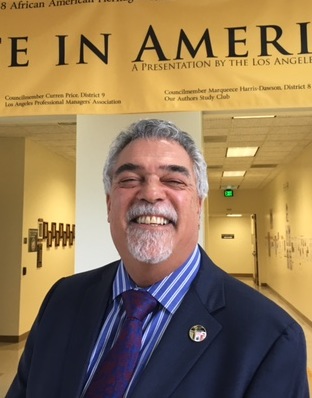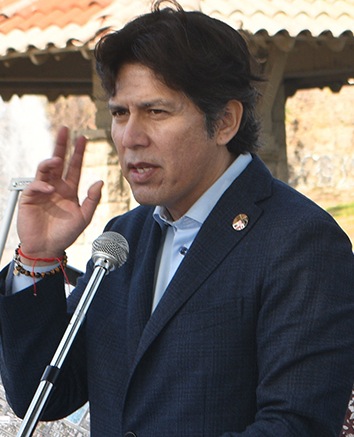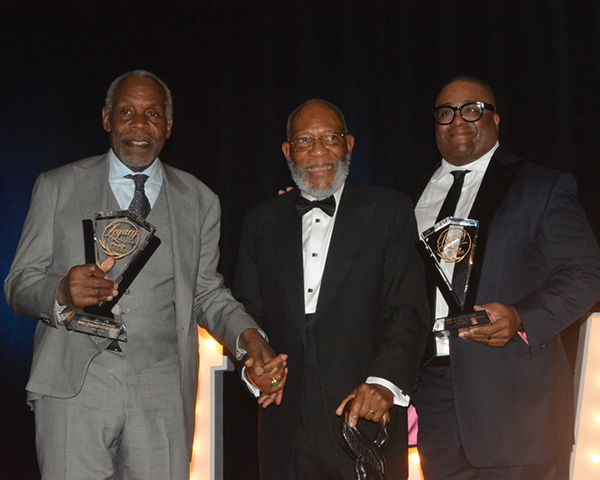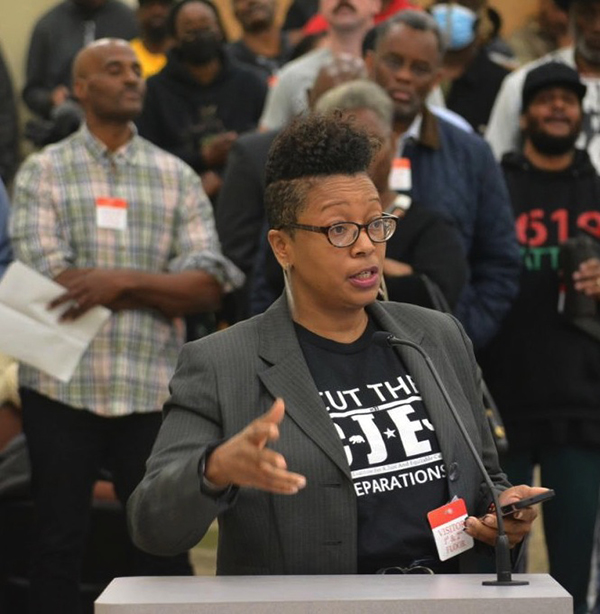Q&A WITH ALBERT LORD
By Darlene Donloe
Contributing Writer
Albert Edmund Lord III is no stranger to rolling up his sleeves and getting to work.
For 16 years he was a deputy for Los Angeles City Council President Herb Wesson where he handled constituent concerns with city services as well as special projects for the district.
For 14 years, from 2006 to 2020, he also was the writer and curator of the African American Heritage Month exhibits for the city of Los Angeles, displayed every February during Black History Month.
Prior to that, he was a sound editor and supervisor in television and film, and an Emmy Award-winning creative with a slew of industry awards, and more than 35 years of experience in radio, post-production, sound editing, live theater and independent film and video production.
On Feb. 18, he began his position as vice president of government relations and art programs for the nonprofit community development corporation Community Build, a South Los Angeles-based organization founded by U.S. Rep. Maxine Waters and Brenda Shockley, (Mayor Eric Garcetti’s deputy mayor for economic opportunity and chief equity officer), in response to the conditions that led to the Los Angeles civil unrest of 1992.
In his new role, Lord will continue his work with the African American Heritage Month Legacy Project in partnership with the city of Los Angeles.
Lord, 69, who was born in San Francisco and raised in Tracy, studied broadcast communication and sociology at San Francisco State.
Contributing Writer Darlene Donloe recently caught up with Lord, a divorced father of two, to talk about his role with Community Build.
DD: Talk about your responsibilities at Community Build?
AEL3: I’m there to assist Community Build in expanding the interaction of what they have done as a gang intervention nonprofit. To lure art-oriented opportunities for the clients in the target demo. The other side of that is to bring resources from other locations, government organizations that may help develop the brand of Community Build and help them grow even larger than what they need to be to serve our community.
DD: What did you think you could bring to the organization?
AEL3: It’s a couple of things. Because they are a gang intervention nonprofit, they don’t have a background in dealing with entertainment or artists. He wanted somebody that could dialogue with artists and with representatives of artists and try to expose the Community Build programming agenda to the entertainment industry. That’s part of my role — to introduce some of the people I have access to — to the role that Community Build is doing as a vehicle to help our young people that are clients of Community Build move into directions that may not have been accessible to them before, short of giving them creative opportunities and turn negative energy into positive energy.
DD: What do you want to ensure happens while you’re in the role?
AEL3: I wanted to make sure that young people get the strong impression that those of us that have been down this road have a course that they can pursue that will build and help create better communities so that there is an option for them that’s safer, and more rewarding for themselves and their families. We change that look that says just because you’re a person of color, it doesn’t mean you have a limited outlook on life. That imagination and your creativity are just as important as anything that’s out there and that you can do it, me being an example of that success.
DD: What do you mean by you as an example?
AEL3: I grew up in a family that is multinational. I’m Black, white, and indigenous. Coming up, there weren’t a lot of opportunities for what I thought I might want to do as a musician. Most in my family had a military background or worked in the sea trade. I wasn’t keen on that. I wanted to be a drummer in a band and travel the world. There weren’t a lot of opportunities. I tried to figure out what I could do to play music.
Through college, I was encouraged to take classes to become employed as a social worker or something like that. Eventually, my mother bought me a guitar. On my way to that class, I got lost and ended up in a junior-level news production class. Are you kidding me? I didn’t know it existed.
I enrolled in the broadcast department. The world just seemed to open up. I found out what I could do, which was talk on the radio and produce music. It was a job to me. It was underneath my nose but I couldn’t smell it. I had an incredible experience in the 70s and 80s at KFRC 610 AM.
DD: You mentioned being partly white. I understand because of your fair coloring, you present as white. Talk to me about that.
AEL3: When you look at me you don’t see ethnicity, unless you’re smart enough. When I go and present myself anywhere, people think I’m Caucasian. I don’t purposely present myself as white — it’s how people see me.
DD: What did you know about gangs before going to work at Community Build?
AEL3: I worked with Herb Wesson and one of the programs we had was a great relationship with Community Build and Project Save. The primary purpose is to keep young people from getting into gangs and helping them get out of the gangs. We put together a week’s retreat. Where Project Save would identify 130 people from the community and Herb would take them on a three-day camping trip. He would provide clothes for them, food for them and activities that would give them exposure to things outside of the neighborhood. I was aware of that relationship and had been involved with them for almost 10 years.
DD: What did you learn after 16 years working with Wesson that you can bring into your new job?
AEL3: One is how to negotiate and how to give. And to imagine what’s possible and try to realize how to convince or bring to the attention of your negotiating opponents how to make it work so it benefits them as well. Also, I learned about concession and vision.
DD: You present as conservative. How do you let your hair down in terms of music, films, television, etc.?
AEL3: I just got into “Star Trek Discovery.”
My favorite music artists are Chicago, Janis Joplin, Sly and the Family Stone, and Tower of Power. I’m an OG of Motown tunes. I love Smokey Robinson and the Miracles. If I could sing, I would want to sing like Smokey Robinson.
My favorite concert was when I went to Golden Gate Park and saw Carlos Santana. There is no greater guitarist on the planet than Jimi Hendrix.
My favorite movie is “Twister.” I love the sound effects and special effects. Also, “The 13th Warrior” with Antonio Banderas. However, two of my favorite movies are the classics “Eve’s Bayou” and “The Preacher’s Wife.” I served as a sound editor on “Eve’s Bayou.” It was a dream working with Whitney Houston.
I always get teased because I like a good musical. Robin Williams did an animated series called “Aladdin.” The singing and animation were incredible. I also loved Will Smith in “Aladdin.”
Darlene Donloe is a freelance reporter for Wave Newspapers who covers South Los Angeles. She can be reached at ddonloe@gmail.com.













